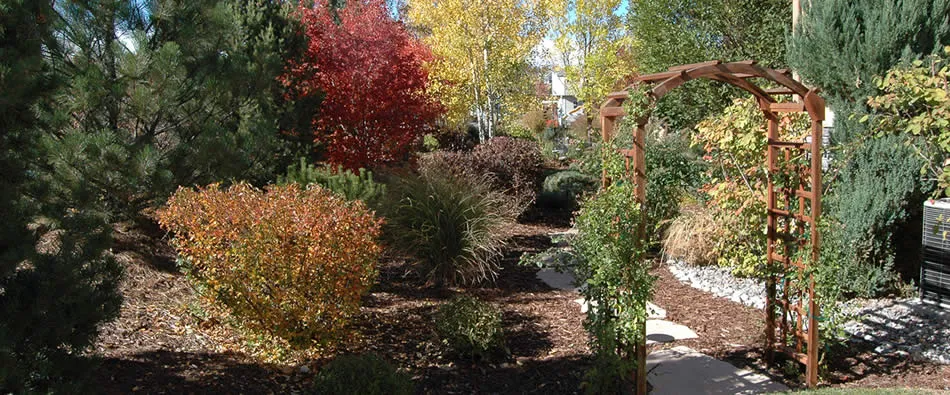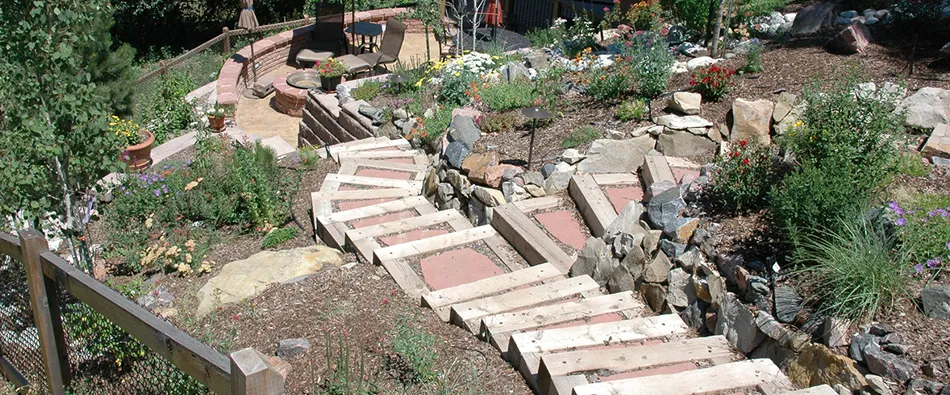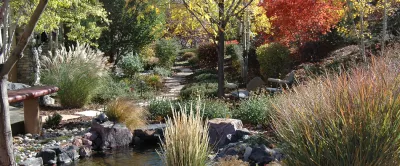The easiest way to minimize landscape maintenance is to plant gardens adapted to the local environment. Weeding, pruning, proper fertilizer and irrigation system adjustments are some of the maintenance practices that need to be kept up with. Aerate the lawn twice a year, spring and fall, to help the water permeate into the root zone.
Xeriscapes, or water-efficient gardens, are earth friendly because they feature plants that thrive on less water. When using plants that require more water, locate them in areas where they can be watered efficiently. Xeriscapes, then, are well-planned, low-maintenance landscapes that are environmentally attuned and require minimal watering, weeding, fertilizing, pest control, and pruning.
Watering can be reduced after one or two years when transplanted plants are established. Less water applied to mature xeriscapes results in fewer weeds and reduced maintenance. Mulch initially covers the ground minimizing weed growth, and when plants begin to mature, their growth covers the soil leaving little light to promote weed growth.
Reduced watering means less plant growth, and less pruning. Adapted plants generally don’t require large amounts of fertilizer. As with any landscape, however, pests can become a problem that require some management.
Xeriscapes require less fossil fuel for mowers and other power maintenance equipment. This not only conserves energy, it means less air pollution.
It’s fun and refreshing to spend time in a xeriscape. While no landscape is totally maintenance free, regionally adapted xeriscapes are as close as you can get.
---------------------------------------------------------------------------------------------------------------------------------------------------------------------------
The selection of a mulch depends on its intended use. Consider the size of the area in relation to the cost of materials and availability.
If the main objective is soil improvement, consider an organic mulch that gradually breaks down. If the area is used primarily for annual flowers, it often is more practical to use a temporary organic mulch, such as composted leaves or grass clippings, that can be turned under each fall. Inorganic mulches such as gravel or stone are a good choice where there are permanent plants in a landscape such as trees, shrubs or perennials.
Mulches can be used to prevent soil erosion by wind and rain. In windy areas, gravel or rock mulch may be preferred over lightweight organic mulches. Any mulch that reduces the impact of raindrops will help reduce water erosion, just make sure the soil surface is entirely covered with mulch. Black plastic (polyethylene) is not recommended as a mulch in landscape areas.
Black plastic is impermeable therefore no oxygen exchange can occur in the soil. Lack of oxygen to the roots significantly reduces plant growth. Black plastic also prevents water penetration. If a weed barrier is needed, use landscape fabrics instead to allow water and oxygen exchange.
When to Apply Mulches
Mulches used to enhance appearance and control weeds may be applied at any time. If the mulch will be used to protect fall transplants by keeping soil temperatures above freezing longer into the fall (permitting better root growth), apply soon after transplanting. Reapply or refresh organic mulches after they have begun to break down.
If the mulch is meant to reduce frost heave and delay spring growth, apply after the ground has frozen. This type of mulch often is used to protect small bulbs such as scilla and crocus and to prevent early emergence.
------------------------------------------------------------------------------------------------------------------------------
There are two primary types of water: surface water and ground water. Surface water is water found above ground — in seas, rivers, creeks and lakes. Ground water is water below the earth’s surface in deposits called aquifers. Some communities in Colorado use surface water while others use a mix of surface and ground water.
All of the water in Denver’s water system is surface water. It comes from snowpack in the mountains, which melts and runs off into four raw water collection systems: the South Platte system, the Moffat system, the Roberts Tunnel system, and the Williams Fork reservoir and power plant.
A large system of conduits and valves helps to transport water from collection systems to a series of reservoirs where it is stored. When the water is needed, conduits carry it to one of three treatment plants, where it is cleaned of impurities and made “potable” — ready to drink. Potable water is stored in a series of underground holding reservoirs until it is used. In 2012, Denver Water treated and delivered over 72 billion gallons of water to over 1.1 million customers.






